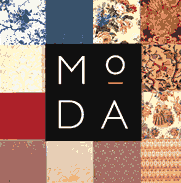Museum of Domestic Design and Architecture facts for kids
 |
|
| Lua error in Module:Location_map at line 420: attempt to index field 'wikibase' (a nil value). | |
| Established | 2000 |
|---|---|
| Location | 9 Boulevard Drive, London, NW9 5HF, United Kingdom |
| Public transit access | |
The Museum of Domestic Design and Architecture (MoDA) was a special museum in North London, England. It held one of the biggest collections of 19th and 20th-century decorative arts for homes. This means it had many beautiful designs for things like wallpapers and textiles (fabrics).
The museum's collections included the Silver Studio collection, the Charles Hasler collection, and the Crown Wallpaper Archive. In 2008, the Silver Studio Collection was officially recognized as very important. Arts Council England said it was of amazing national and international quality.
MoDA was part of Middlesex University. From 2000 to 2011, the museum was at Cat Hill, Barnet. It showed cool exhibitions like "Japantastic" in 2010, which explored Japanese-inspired patterns in British homes.
From 2011 to 2023, the MoDA Collections Centre was in Colindale. During this time, the museum worked on interesting projects. It even had a podcast called 'That Feels Like Home'. The museum closed its doors to visitors in September 2023. All its operations finished by July 2024.
Contents
The Silver Studio Collection: Designs for Your Home
The Silver Studio was a company that created designs for many years. It was run by the Silver family in West London. From 1880 to 1963, they made over 20,000 designs. These were for things like fabrics, wallpapers, tablecloths, and carpets.
The Studio hired many designers. Some, like Archibald Knox, became famous. Others worked behind the scenes, and their names are not as well known.
The Silver Studio sold its designs to shops and factories. These companies made wallpapers and textiles for everyone. They sold to places that made cheap items and also to those making high-quality products. Famous British textile makers bought their designs. Even the well-known department store, Liberty, was a client.
Because many clients made things for the general public, Silver Studio designs were in countless British homes. Their influence on home styles lasted a very long time. Many of their designs were produced and used.
After the Studio closed in the early 1960s, its designs went to Hornsey College of Art. This college later became part of Middlesex University. The Silver Studio's importance was recognized in 1981. A special blue plaque was placed on their old home and studio building in Hammersmith.
While at MoDA, the Silver Studio Collection helped many people. Historians used it to learn about home interiors. Students and artists used it for inspiration.
Charles Hasler Collection: A Designer's World
This collection belonged to Charles Hasler (1908-1992). He was a designer and typographer. A typographer is someone who designs how words look on a page. Hasler was very important in British design from the 1930s to the 1980s. He worked on big exhibitions, posters, and books.
From 1942 to 1951, Hasler designed exhibitions for the government. He worked on famous campaigns like ‘Dig For Victory’ and ‘Make Do and Mend’. After World War II, he became a top designer for the Festival of Britain in 1951.
Hasler also taught about design. He helped educate new print and graphic designers. He was very interested in new ideas like packaging and branding. His collection shows his love for all kinds of printed items. It includes postcards, posters, and old sheet music.
In May 2024, the Charles Hasler Collection moved. It is now part of the University of Reading Special Collections. It joins other important collections about British printing.
Crown Wallpaper Archive: A Look at British Taste
MoDA's Crown Wallpaper Collection had about 5,000 wallpaper albums and samples. These dated from the early 1950s to the late 1960s. Crown Wallpapers gave them to the museum in 1989.
This collection, along with the Silver Studio wallpapers, was very special. It showed wallpapers made for everyday people, not just the very rich. It gives us a great idea of what British people liked in their homes for many years.
When the museum closed, most of the Crown Wallpaper collection was shared. It went to the Whitworth Art Gallery and Sanderson Design Group.
Domestic Design Collection: Homes and Gardens
This collection had over 4,000 books, magazines, and catalogs. They covered everything about home furnishing, managing a household, cooking, building homes, DIY, crafts, and gardening.
A key part of this collection focused on North London suburbs. It showed how these areas grew between 1900 and 1939. It included posters and brochures from builders and real estate agents. This material helped show how homes were decorated and furnished during that time.
What Happened to the Collections?
When MoDA closed in 2024, its collections were carefully shared. Different parts went to various institutions. This ensured these important items would still be available for study and enjoyment.
- Material about suburbs went to Enfield Local Studies Archive and Ealing Local Studies Archive.
- The University of Brighton Design Archives received items about the Festival of Britain. They also got designs by Enid Marx and Laurence Scarfe.
- Manchester Metropolitan University Special Collections Museum and Buckinghamshire New University each took some trade and retail catalogs.
- The Knitting Reference Library at Winchester School of Art received knitting patterns and magazines.
- Gunnersbury Park and Museum got tiles and other items by artist Eleanor Greeves.
- Paint charts and items about Ripolin paint went to Tate Archive.
- A collection of cookery books moved to the Food Museum.
- Sanderson Design Group and The Whitworth Art Gallery each received some wallpapers and textiles.
- Lancaster City Museums and Kirkcaldy Galleries received items related to linoleum.
- Braintree District Museum received Bardfield wallpapers.
- Stories and images of home interiors from the public went to the Mass Observation Archive. This archive also received images of homes used for TV and film.

